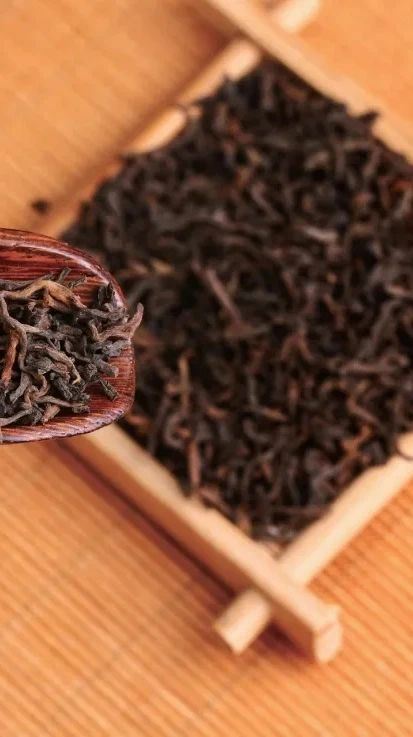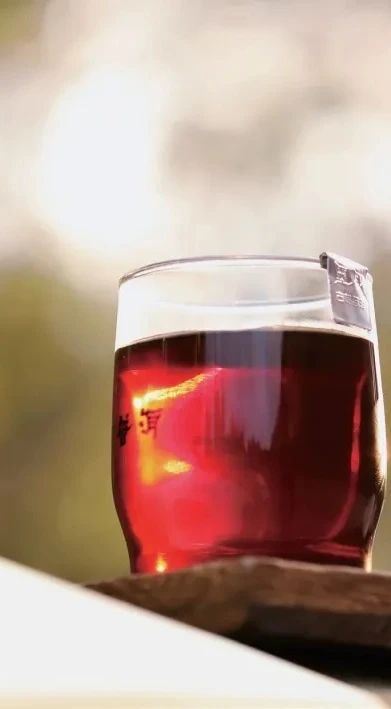

Ripened
Tea
If the first life of ripened tea comes from the raw materials picked from the tea bushes;
then its second life comes from the pile-fermentation process;
and its third life is during the brewing.
From dehydration to rehydration, then drying again and rehydrating, a piece of ripened tea completes three rounds of tempering, blooming with the most splendid part of its life.
Its mildness, full-bodiedness, and sweetness bring warmth and health to people.
Ripened tea can be said to be the mildest among all types of tea, as its fermentation degree is the highest among all teas (excluding naturally aged old teas).
In fully fermented teas, it has a longer fermentation time and higher degree than Black Tea, Anhua dark tea, etc.
Therefore, the requirements for brewing ripened tea are relatively low. As long as the quality of the ripened tea is excellent, it tastes good no matter how you brew it, whether strong or light.
For example, the popular method of brewing in an insulated cup in the tea circle is usually used for ripened tea.
Of course, some brewing techniques applied to ripened tea not only make it taste better but also can cover up some defects in the processing of certain ripened teas.
Below, let's take a look at the basic brewing methods for ripened tea:
Preparation Before Brewing
ONE
/ Awaken the Tea
Awakening the tea is one of the essential steps before brewing ripened tea.
Whether it is a slightly aged ripened tea or a newly made one, awakening is necessary.
For compressed ripened Pu'er such as cakes, bricks, and tuos, you can start the awakening process about a week before you plan to drink it.
Break the cake or brick into pieces roughly the size of a coin.
Store them in a clay jar or purple clay jar, allowing the leaves to come into contact with air appropriately, adjusting their internal moisture content. The heap-fermentation smell of new teas and the storage smell of aged teas will dissipate moderately, which is beneficial for the subsequent brewing.
It's important to note that the jar should not be too full, about two-thirds full, leaving enough space for the tea leaves to come into more contact with air.
TWO
/ Teaware
Generally, a purple clay pot is recommended for brewing ripened tea.
The unique heat retention, breathability, and adsorption properties of purple clay pots make the tea soup smoother.
The double-pore structure of purple clay pots can absorb impurities, absorbing some of the heap-fermentation smell and other impurities of ripened tea.
If there is no purple clay pot, a porcelain lid bowl is also fine.
The high density of porcelain lid bowls and the glazing on them make them less breathable and heat-retaining than purple clay, but they can highly reproduce the original flavor of the tea.
With slightly inferior heat retention, adjusting the amount of tea and the pouring time can still produce a delicious tea soup.
Of course, the biggest difference between these two types of teaware is the price.
Purple clay pots are more expensive, with a large price range, and it's difficult to identify the clay material, so beginners should use them with caution.
Lid bowls are cheaper but easy to burn your hands. It's best to choose a lid bowl with a wider rim, which can reduce the risk of burning.
Another option is Jian Shui purple clay Teapot, which also has advantages when brewing ripened tea.
The density of purple clay is much higher than that of purple clay, retaining the aroma and taste of the tea without being absorbed by the teaware.
The brewed tea soup is more fragrant and flavorful.
Moreover, the good thermal conductivity of purple clay means that the temperature inside the pot rises quickly when the tea needs to be heated. To maintain a high temperature, simply pour hot water over the pot.
THREE
/ Water for Brewing
As the saying goes, “Water is the mother of tea,” and the influence of water on brewing cannot be underestimated.
Lu Yu said, “Mountain spring water is the best, river water is the next best, and well water is the worst.”
However, for modern people, these three types of water are not easily accessible.
Moreover, with serious environmental pollution nowadays, natural water may not be healthy and could contain bacteria and microorganisms.
For daily tea brewing, choosing bottled mineral water or purified water can be a relatively simple and safe choice.
Deeply purified tap water is also a very economical choice.
Many residential areas now have large water purifiers, and the purified tap water has a good taste, not inferior to ordinary bottled water. The key is that it's fresh water.
Of course, some people in the tea circle recommend specific brands of water.
However, the author believes that ripened tea is a daily staple tea, a mass beverage, so there is no need to be too picky. Bottled water and purified water are sufficient.
FOUR
/ Kettle for Boiling Water
The kettle for boiling water is preferably a cast iron kettle because of its good heat retention and insulation properties.
However, for everyday brewing, a stainless steel electric kettle is fine.
Additionally, to control the flow of water, the spout design of the kettle should be reasonable, allowing the water line to be smooth and steady. It should be able to control the thickness, fineness, and speed of the water line freely.
FIVE
/ Amount of Tea
The amount of tea added should be moderate. If too much tea is added, the color of the tea soup may resemble soy sauce;
if too little, the taste will be thin, affecting the drinking experience.
Specifically, the amount of tea added can be determined based on the number of people and the size of the brewing utensil.
Generally, for a 110ml container, 7 grams of tea is added, which basically ensures a balanced ratio.
Individuals can adjust according to their taste, while also adjusting the brewing time per infusion to complement each other.
For example, if you want to have more infusions, you can increase the amount of tea added and try to pour out the water quickly in the initial few infusions.


Brewing Process for Ripened Tea
ONE
/ Pre-infusion
Both loose and compressed ripened tea may have varying degrees of tightness or clumping.
Pre-infusion helps the tea to evenly expand, thereby better expressing its character.
Secondly, after the water-sprinkling pile-fermentation process, ripened tea inevitably picks up some dust.
A pre-infusion procedure helps to wash away impurities and dust on the tea.
Note that the pre-infusion time should not be too long.
Infuse with hot water; generally, for loose ripened tea, pre-infuse for 3-5 seconds;
for compressed ripened Pu'er, pre-infuse for about 5-10 seconds.
After the pre-infusion water is poured out, lift the lid to smell the aroma. Once the aroma comes out, the pre-infusion is complete. If the aroma does not come out or the aroma is not right, continue the process.
Generally, 1-2 pre-infusions are enough.
During pre-infusion, warming the cups is generally required.
However, since